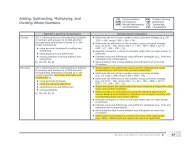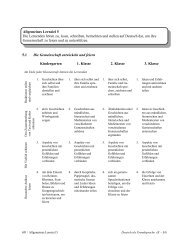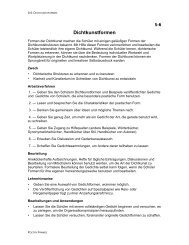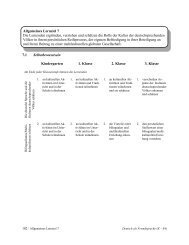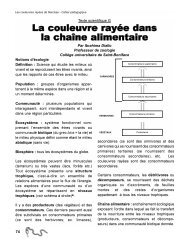Lesson 3: Anxiety and Depression
Lesson 3: Anxiety and Depression
Lesson 3: Anxiety and Depression
You also want an ePaper? Increase the reach of your titles
YUMPU automatically turns print PDFs into web optimized ePapers that Google loves.
<strong>Lesson</strong> 3: <strong>Anxiety</strong> <strong>and</strong> <strong>Depression</strong><br />
Introduction<br />
This lesson focuses on two of the more common mental health issues, anxiety <strong>and</strong><br />
depression, <strong>and</strong> how an active healthy lifestyle can be a positive influence on them.<br />
Although a number of healthy lifestyle practices are discussed in this lesson, the primary<br />
emphasis is on the benefits derived from physical activity.<br />
<strong>Anxiety</strong> <strong>and</strong> depression affect all people in one way or another. They are considered<br />
disorders only when these feelings are almost always there <strong>and</strong> when they significantly<br />
interfere with daily life. In A Report on Mental Illnesses in Canada, Health Canada reports<br />
the following:<br />
• “<strong>Anxiety</strong> disorders affect 12% of the population, causing mild to severe impairment.<br />
• For a variety of reasons, many individuals may not seek treatment for their anxiety;<br />
they may consider the symptoms mild or normal, or the symptoms themselves may<br />
interfere with help-seeking” (Chapter 4, Highlights).<br />
It is important to remove the stigma of weakness associated with seeking help if one is<br />
feeling overwhelmed, anxious, or depressed. People who are experiencing anxious<br />
behaviour or any other mental health problem that is significantly interfering with daily<br />
living should feel that is not only OK, but also wise to seek medical advice, just as they<br />
would for physical injuries.<br />
R EFERENCES<br />
For additional information, refer to the following resources:<br />
<strong>Anxiety</strong> Disorder Association of British Columbia (<strong>Anxiety</strong>BC). .<br />
Health Canada. “Chapter 4: <strong>Anxiety</strong> Disorders.” A Report on Mental Illnesses in Canada.<br />
Ottawa, ON: Health Canada, 2002. Available on the Public Health Agency of Canada<br />
website at .<br />
For website updates, please visit Websites to Support the Grades 11 <strong>and</strong> 12 Curriculum at<br />
.<br />
________________________________________________________________________________<br />
_____________________________________________________________________________<br />
Module C, <strong>Lesson</strong> 3 225 •
Specific Learning Outcomes<br />
11.MH.1<br />
11.MH.4<br />
11.MH.5<br />
Identify <strong>and</strong> apply positive health strategies to deal with issues such as stress,<br />
anxiety, depression, <strong>and</strong> eating disorders.<br />
Examine the signs <strong>and</strong> symptoms of mental-emotional health issues related to<br />
stress, anxiety, depression, <strong>and</strong> eating disorders.<br />
Identify community service agencies that support individuals concerned about<br />
mental-emotional health issues.<br />
11.MH.6<br />
Apply problem-solving <strong>and</strong> decision-making strategies in case scenarios<br />
related to selected mental-emotional health issues.<br />
________________________________________________________________________________<br />
Key Underst<strong>and</strong>ings<br />
• <strong>Anxiety</strong> may make people feel anxious most of the time without an obvious reason.<br />
• <strong>Anxiety</strong> has a wide range of signs <strong>and</strong> symptoms.<br />
• Major depression is a medical condition characterized by long-lasting feelings of<br />
intense sadness <strong>and</strong> hopelessness, with a biological <strong>and</strong> chemical basis.<br />
• Active healthy lifestyle practices are helpful in dealing with anxiety <strong>and</strong> depression<br />
<strong>and</strong> support positive mental-emotional health.<br />
• Community service agencies are available to support individuals concerned about<br />
mental-emotional health issues.<br />
________________________________________________________________________________<br />
Essential Questions<br />
1. What are important signs <strong>and</strong> symptoms of anxiety <strong>and</strong> depression?<br />
2. How does an active healthy lifestyle support positive mental-emotional health?<br />
3. What health agencies support issues of mental-emotional health in your community?<br />
________________________________________________________________________________<br />
_____________________________________________________________________________<br />
226 Grade 11 Active Healthy Lifestyles<br />
•
Background Information<br />
<strong>Anxiety</strong> Disorders<br />
<strong>Anxiety</strong>, or feeling anxious, describes a mood familiar to most of us, one that we may<br />
experience every day. <strong>Anxiety</strong> comes from a concern over lack of control over<br />
circumstances. In some cases being anxious <strong>and</strong> worrying over a problem may generate a<br />
solution. Normally, however, it will just result in negative thinking. When anxiety seems<br />
to come out of nowhere, is excessive, persists for many weeks without relief, or interferes<br />
with everyday life, it may not be an ordinary mood anymore. It may be an illness.<br />
Signs <strong>and</strong> Symptoms<br />
People with an anxiety disorder may have a number of common physical symptoms,<br />
including the following (Canadian Psychiatric Association; <strong>Anxiety</strong> Disorders Association<br />
of Manitoba; <strong>Anxiety</strong>BC):<br />
• shortness of breath ■ feelings of unreality<br />
• shakiness ■ irritability<br />
• muscle aches <strong>and</strong> tension ■ insomnia<br />
• tight chest ■ restlessness<br />
• racing heart ■ sweating <strong>and</strong> nausea<br />
• choking sensations ■ abdominal distress<br />
• numbness or tingling<br />
Emotionally, people with an anxiety disorder may feel short-tempered <strong>and</strong> apprehensive,<br />
fearing that bad things are about to happen.<br />
According to the <strong>Anxiety</strong> Disorders Association of Manitoba (ADAM), anxiety disorders<br />
are among the most common mental health problems. They can cause “significant<br />
personal <strong>and</strong> societal costs in terms of lost wages, decreased productivity, reduced quality<br />
of life <strong>and</strong> frequent use of health care services” (ADAM, Major <strong>Anxiety</strong> Disorders).<br />
The different types of anxiety disorders include generalized anxiety disorder, panic<br />
disorder, specific phobias, social anxiety disorder, obsessive compulsive disorder, <strong>and</strong><br />
post-traumatic stress disorder, which medical professionals would diagnose before<br />
providing treatment.<br />
_____________________________________________________________________________<br />
Module C, <strong>Lesson</strong> 3 227 •
Causes<br />
As stated by ADAM, “research indicates that there is no single explanation for the cause<br />
of anxiety disorders but that several . . . factors may contribute to their origins” (Major<br />
<strong>Anxiety</strong> Disorders). The causes of anxiety may include the following (Manitoba Healthy<br />
Schools, “<strong>Anxiety</strong>”):<br />
• inherited tendency ■ stressful experiences<br />
• shy temperament ■ anxious parents<br />
• unpredictable lifestyle<br />
R EFERENCES<br />
For information on anxiety disorders, refer to the following websites:<br />
<strong>Anxiety</strong> Disorder Association of British Columbia (<strong>Anxiety</strong>BC). “Overview of <strong>Anxiety</strong><br />
Disorders.” .<br />
<strong>Anxiety</strong> Disorders Association of Manitoba (ADAM). Major <strong>Anxiety</strong> Disorders.<br />
.<br />
Canadian Psychiatric Association. “<strong>Anxiety</strong>, <strong>Depression</strong> <strong>and</strong> Manic <strong>Depression</strong>.” Public<br />
Education Materials. .<br />
Manitoba Healthy Schools. “<strong>Anxiety</strong>.” Mental Health.<br />
.<br />
For website updates, please visit Websites to Support the Grades 11 <strong>and</strong> 12 Curriculum at<br />
.<br />
<strong>Depression</strong><br />
<strong>Depression</strong> is a mental disorder that affects a person’s thoughts, moods, feelings,<br />
behaviour, <strong>and</strong> physical health. People once thought that depression was “all in the head”<br />
<strong>and</strong> that if one really tried, one could “snap out of it” or just “get over it.” Some people<br />
still respond to depression in this way. Health professionals now know that depression is<br />
not a weakness, <strong>and</strong> it is not something people can treat on their own. <strong>Depression</strong> is a<br />
medical disorder with a biological <strong>and</strong> chemical basis, <strong>and</strong> it may affect people of all ages<br />
or nationalities. Some mental health problems, such as bipolar depression or major<br />
depression, tend to run in families due to genetics or family interaction styles.<br />
Sometimes depression is triggered by a stressful life event. At other times depression<br />
seems to occur spontaneously with no specific identifiable cause. <strong>Depression</strong> is much<br />
more than grieving or experiencing a bout of sadness.<br />
<strong>Depression</strong> may occur only once in a person’s life, or it could occur sporadically<br />
throughout life, with periods when the person would not feel depressed. It may also be a<br />
chronic condition, which may require ongoing treatment over a lifetime. With proper<br />
treatment, most people with serious depression improve within weeks, <strong>and</strong> can return to<br />
normal daily activities.<br />
_____________________________________________________________________________<br />
228 Grade 11 Active Healthy Lifestyles<br />
•
Signs <strong>and</strong> Symptoms<br />
The two main symptoms associated with depression are lack of interest in normal daily<br />
living, even in the activities that are enjoyable, <strong>and</strong> feeling miserable or “down in the<br />
dumps.” A depressed person shows feelings of sadness <strong>and</strong> helplessness, or may cry<br />
often.<br />
A health professional would also look for other signs <strong>and</strong> symptoms lasting at least two<br />
weeks, such as changes in sleep patterns, concentration, weight or eating patterns,<br />
demeanour (more irritable), self-esteem, <strong>and</strong> desire to live. Physical complaints, such as<br />
gastrointestinal problems (indigestion, constipation, or diarrhoea), headache, <strong>and</strong><br />
backache may also be signs.<br />
Different age groups may react differently to depression. Sometimes it is confusing to<br />
determine what the actual problem is because the behaviour is a cover-up for the real<br />
problem. For example, children may pretend to be sick, worry about being bullied, not do<br />
well in school, or act out to cover up their feelings of sadness. Older people may focus<br />
more on complaining about the physical symptoms of depression than on what situations<br />
or emotions are causing them to feel that way.<br />
The primary types of depression include major depression, dysthymia, adjustment<br />
disorders, bipolar disorder, <strong>and</strong> seasonal affective disorder (Mayo Clinic). These types of<br />
depression have similarities <strong>and</strong> differences. It is important that people who suffer from<br />
depression obtain proper diagnosis from a medical professional rather than attempting<br />
self-diagnosis.<br />
R EFERENCES<br />
For additional information on the signs <strong>and</strong> symptoms of depression <strong>and</strong> definitions of the<br />
primary types of depression, refer to the following websites:<br />
Canadian Mental Health Association. Mental Health <strong>and</strong> High School.<br />
.<br />
Finding Optimism: Health in Response to Mental Health. “Things to Say to Someone with<br />
<strong>Depression</strong>.” Healthy Mind. .<br />
Health Canada. “Chapter 2: Mood Disorders.” A Report on Mental Illnesses in Canada.<br />
Ottawa, ON: Health Canada, 2002. Available on the Public Health Agency of Canada<br />
website at .<br />
Mayo Clinic. <strong>Depression</strong>.<br />
.<br />
For website updates, please visit Websites to Support the Grades 11 <strong>and</strong> 12 Curriculum at<br />
.<br />
________________________________________________________________________________<br />
_____________________________________________________________________________<br />
Module C, <strong>Lesson</strong> 3 229 •
Suggestion for Instruction / Assessment<br />
Signs <strong>and</strong> Symptoms of Mental Health Issues<br />
Ask students to think about the signs <strong>and</strong> symptoms of<br />
selected disorders, using the information from this lesson.<br />
Have students record on a T-Chart what each disorder<br />
“looks like” <strong>and</strong> “feels like” as it relates to the signs <strong>and</strong><br />
symptoms.<br />
Disorder:<br />
Looks Like<br />
Feels Like<br />
________________________________________________________________________________<br />
Suggestion for Instruction / Assessment<br />
Self-Assessment of Mental Health<br />
Check websites for sample mental health assessments.<br />
Examples of self-tests include the following:<br />
• <strong>Anxiety</strong> Test<br />
• Coping Skills Test<br />
• Eating Disorders <strong>and</strong> Emotional Eating Test<br />
• Optimism/Pessimism Test<br />
N OTE TO T EACHER<br />
Educators are advised to preview<br />
<strong>and</strong> evaluate websites <strong>and</strong> online<br />
resources before recommending<br />
them for student use. Ensure that<br />
the selected websites <strong>and</strong> tests are<br />
appropriate for student use.<br />
• Resilience Test<br />
• Self-Esteem Test<br />
• Social <strong>Anxiety</strong> Test<br />
Have students choose a self-test they would like to try. Provide students with an<br />
opportunity to discuss results, if desired.<br />
R EFERENCE<br />
A variety of mental health assessment tests are available on the following website:<br />
Discovery Health. “Mental Health Assessments.” Mental Health. 2007.<br />
.<br />
For website updates, please visit Websites to Support the Grades 11 <strong>and</strong> 12 Curriculum at<br />
.<br />
________________________________________________________________________________<br />
_____________________________________________________________________________<br />
230 Grade 11 Active Healthy Lifestyles<br />
•
Suggestion for Instruction / Assessment<br />
Signs <strong>and</strong> Symptoms of Mental Health Issues<br />
This learning activity will enable students to become more acquainted with various<br />
mental health issues <strong>and</strong> some of their signs <strong>and</strong> symptoms. An assumption is that<br />
teachers have already addressed these topics in class <strong>and</strong> are using this learning activity<br />
primarily for review or for application of learning.<br />
Refer to RM 6–MH: Mental Health Scenarios.<br />
________________________________________________________________________________<br />
R EFERENCES<br />
The following annotated bibliography is intended to be used as a reference for selecting<br />
student <strong>and</strong> teacher learning resources. Decisions related to choice of learning resources are<br />
determined at the local school/division level.<br />
Manitoba Education, Citizenship <strong>and</strong> Youth. Physical Education/Health Education Learning<br />
Resources: Kindergarten to Senior 2: Compilation of Annotated Bibliographies (2002-<br />
2004). Winnipeg, MB: Manitoba Education, Citizenship <strong>and</strong> Youth, 2004. Available online<br />
at .<br />
Additional information about anxiety <strong>and</strong> depression may be obtained from the following<br />
websites:<br />
Canadian Mental Health Association. Mental Health <strong>and</strong> High School.<br />
.<br />
---. “Resources.” Work-Life Balance: It’s a Matter of Time.<br />
.<br />
Health Canada. “Mental Health.” Healthy Living. .<br />
Manitoba Healthy Schools. Mental Health.<br />
.<br />
Manitoba Health. Mental Health <strong>and</strong> Addictions. .<br />
Mental Health Canada. Diseases <strong>and</strong> Disorders.<br />
.<br />
Mental Health Education Resource Centre (MHERC) Manitoba. Mental Health Disorders <strong>and</strong><br />
Issues. .<br />
Mental Health First Aid. .<br />
National Institute of Mental Health. “The Numbers Count: Mental Disorders in America.”<br />
Health <strong>and</strong> Outreach. .<br />
Safe Healthy Schools. “Mental Health <strong>and</strong> Schools.” Communities <strong>and</strong> Schools Promoting<br />
Health. .<br />
For website updates, please visit Websites to Support the Grades 11 <strong>and</strong> 12 Curriculum at<br />
.<br />
_____________________________________________________________________________<br />
Module C, <strong>Lesson</strong> 3 231 •
Background Information<br />
Prevention Strategies<br />
Learning how to control our feelings through healthy lifestyle practices can help us reduce<br />
or prevent anxiety. Stress-management strategies may include deep breathing, relaxation,<br />
guided imagery or visualization, yoga, meditation, <strong>and</strong> calming self-talk.<br />
Physical exercise can be a key element in reducing anxiety (Repich). Some research<br />
evidence suggests the following:<br />
Exercise raises the levels of certain mood-enhancing neurotransmitters in the brain.<br />
Exercise may also boost feel-good endorphins, release muscle tension, help you sleep<br />
better, <strong>and</strong> reduce levels of the stress hormone cortisol. It also increases body<br />
temperature, which may have calming effects. All of these changes in your mind <strong>and</strong><br />
body can improve such symptoms as sadness, anxiety, irritability, stress, fatigue,<br />
anger, self-doubt <strong>and</strong> hopelessness. (Mayo Clinic)<br />
Exercise isn’t a cure for depression or anxiety, but its psychological <strong>and</strong> physical benefits<br />
can improve the symptoms.<br />
R EFERENCES<br />
For additional information on the benefits of exercise for mental-emotional health, refer to<br />
the following websites:<br />
Khan, Adam. “Exercise.” YouMe Works. .<br />
Mayo Clinic. “<strong>Depression</strong> <strong>and</strong> <strong>Anxiety</strong>: Exercise Eases Symptoms.” <strong>Depression</strong>.<br />
.<br />
Repich, Deanne. “Exercise Your <strong>Anxiety</strong> Away!” Health Articles. 2007.<br />
.<br />
For website updates, please visit Websites to Support the Grades 11 <strong>and</strong> 12 Curriculum at<br />
.<br />
________________________________________________________________________________<br />
Suggestion for Instruction / Assessment<br />
Exercise as the Best Preventive Medicine<br />
Building on the information from <strong>Lesson</strong> 1 of Module C, have students research the<br />
benefits of exercise <strong>and</strong> physical activity for mental-emotional health <strong>and</strong> present their<br />
findings in different ways (e.g., a poster, a rap song, an advertisement, an acrostic). An<br />
example follows.<br />
_____________________________________________________________________________<br />
232 Grade 11 Active Healthy Lifestyles<br />
•
E XAMPLE<br />
In the following example, an acrostic (BE ACTIVE) is used to promote the benefits of exercise <strong>and</strong><br />
physical activity:<br />
B – Breath<br />
E – Exercise<br />
A – Attitude<br />
C – Confidence<br />
T – Time<br />
I – Inactive<br />
V – Vigorous<br />
E – Endorphin<br />
Taking deep breaths is an effective relaxation technique <strong>and</strong> helps reduce<br />
stress-related symptoms.<br />
Exercise increases levels of serotonin, dopamine, <strong>and</strong> norepinephrine, which are<br />
neurotransmitters that help elevate or improve mood.<br />
Taking a positive attitude is a strategy for reducing stress <strong>and</strong> dealing with<br />
anxiety.<br />
A person can develop confidence through exercise or training, because the body<br />
becomes stronger <strong>and</strong> the physical activity becomes easier.<br />
Planning a time to be active every day is important to good mental <strong>and</strong> emotional<br />
health. Regular physical activity can help improve sleep, decrease anxiety, <strong>and</strong><br />
enhance ability to cope with stress.<br />
Being inactive puts a person at risk for developing various chronic diseases <strong>and</strong><br />
mental health issues.<br />
Vigorous exercise contributes to developing cardiovascular/respiratory<br />
endurance. The health benefits associated with cardiovascular fitness include<br />
easier weight management, improved sleeping habits, decreased anxiety, reduced<br />
depression, improved ability to cope with stress, improved mood, <strong>and</strong> enhanced<br />
self-esteem.<br />
It is believed that, in response to exercise, the body releases different chemicals,<br />
such as endorphins, which affect the brain. Endorphins have a pain-relieving<br />
effect on the body <strong>and</strong> produce a feeling of euphoria.<br />
R EFERENCE<br />
The following is an example of a song that promotes active healthy living. The song lyrics,<br />
as well as an audio clip <strong>and</strong> video clip of the song, are available on the Manitoba Education,<br />
Citizenship <strong>and</strong> Youth website.<br />
Burnett, Aaron. Get off the Couch. Audio <strong>and</strong> video clip. 2003.<br />
.<br />
For website updates, please visit Websites to Support the Grades 11 <strong>and</strong> 12 Curriculum at<br />
.<br />
________________________________________________________________________________<br />
_____________________________________________________________________________<br />
Module C, <strong>Lesson</strong> 3 233 •
Background Information<br />
Seeking Professional Help<br />
The diagnosis of depression should be left to a health professional. There are basic<br />
questions to ask that may help steer a person in the direction of seeking professional<br />
mental health care.<br />
R EFERENCE<br />
For a list of questions, refer to the following website:<br />
Aetna InteliHealth. “Are You Depressed?” Diseases <strong>and</strong> Conditions.<br />
.<br />
For website updates, please visit Websites to Support the Grades 11 <strong>and</strong> 12 Curriculum at<br />
.<br />
________________________________________________________________________________<br />
Suggestion for Instruction / Assessment<br />
Community Supports <strong>and</strong> Services<br />
Have students use a variety of resources (e.g., Internet, directories, regional health<br />
authority, counsellors) to research supports <strong>and</strong> services for mental-emotional health<br />
issues available in the local community or in the province. Ask students to include the<br />
name of the agency or organization, identify contact information, <strong>and</strong> describe the<br />
supports <strong>and</strong> services provided.<br />
Agency Contact Information Supports <strong>and</strong> Services Provided<br />
R EFERENCE<br />
For ideas on supports <strong>and</strong> services available in Manitoba, refer to the following website:<br />
Manitoba Healthy Schools. “Where Can I Go for Help?” Mental Health.<br />
.<br />
For website updates, please visit Websites to Support the Grades 11 <strong>and</strong> 12 Curriculum at<br />
.<br />
________________________________________________________________________________<br />
_____________________________________________________________________________<br />
234 Grade 11 Active Healthy Lifestyles<br />
•
RM 6–MH: Mental Health Scenarios*<br />
This learning activity will enable students to become more acquainted with various<br />
mental health issues <strong>and</strong> some of their signs <strong>and</strong> symptoms. An assumption is that<br />
teachers have already addressed these topics in class <strong>and</strong> are using this learning activity<br />
primarily for review or application of learning.<br />
Materials Needed<br />
• slips of paper with a different mental health scenario on each (see the following page)<br />
• notes taken in class<br />
• a health book<br />
Directions<br />
Place the class into groups of three or four students. Have one person from each group<br />
pick a slip of paper that outlines a specific mental health scenario. Advise students that<br />
the groups will have approximately 10 minutes to figure out which mental health issue<br />
their selected scenario describes <strong>and</strong> to respond to three questions, providing explanations<br />
for their answers:<br />
1. From what mental health issue do you think the person described in the scenario is<br />
suffering? Provide reasons for your decision (signs, symptoms, <strong>and</strong> possible causes of<br />
the mental health issue).<br />
2. What advice <strong>and</strong> assistance would you offer the person in the scenario? Explain.<br />
3. Which health care professionals would best be able to help the person? Give reasons.<br />
When the 10 minutes are up, the groups take turns reading their scenarios to the class <strong>and</strong><br />
presenting their response to the three problem-solving challenges. During the class<br />
discussion, the teacher can include any other important information that is appropriate.<br />
Continued<br />
__________<br />
* Source of adaptation: Ballard, Michelle. “Mental Health Scenarios.” PE Central: Health <strong>Lesson</strong> Ideas. 2002.<br />
. Used by permission of PE Central (percentral.org), the<br />
premier website for physical education teachers.<br />
_____________________________________________________________________________<br />
Module C, <strong>Lesson</strong> 3 235 •
RM 6–MH: Mental Health Scenarios (Continued)<br />
Mental Health Scenarios<br />
Below are a few scenarios that may indicate a mental health issue. Teachers are<br />
encouraged to make up more scenarios for any other mental health topics addressed in<br />
class.<br />
1. Suzie’s mother died a year ago, but Suzie just can’t seem to move on. Suzie is still<br />
having a hard time sleeping at night <strong>and</strong> concentrating in school. Last week, I even<br />
caught Suzie crying in the school washroom. Some people have seen her take some<br />
pills.<br />
2. Br<strong>and</strong>on has recently graduated from high school <strong>and</strong> will be attending a local<br />
university this year. Br<strong>and</strong>on was always exercising <strong>and</strong> working out in high school.<br />
He now spends a lot of time weight training at the gym. He’s been putting on a lot of<br />
muscle lately, <strong>and</strong> he is always talking about working out <strong>and</strong> getting bigger. Br<strong>and</strong>on<br />
takes supplements, drinks protein shakes, <strong>and</strong> has started using creatine (amino acid).<br />
When I’m talking to Br<strong>and</strong>on it almost sounds as if he wants to become the next<br />
“superman.” I’m really worried about Br<strong>and</strong>on because he gets agitated <strong>and</strong> angry<br />
very easily.<br />
3. Jenny is my best friend. We both play volleyball. We’ve been playing volleyball<br />
together since Grade 7. I’ve noticed that every winter Jenny withdraws from her<br />
friends <strong>and</strong> always seems sad. Every winter, I think that it’s me . . . that I’ve done<br />
something to Jenny to upset her. Once spring hits, Jenny slowly returns to her<br />
“normal” self.<br />
4. Chris is constantly worried about catching colds. In fact, Chris washes his h<strong>and</strong>s just<br />
about 20 times a day. When asked, Chris says that he cannot afford to be sick, <strong>and</strong> then<br />
goes into a lecture about how many germs there are around. Sometimes Chris washes<br />
his h<strong>and</strong>s so much that they bleed.<br />
5. Hailey’s parents were divorced when she was six. Since then, she has been spending<br />
every second weekend with her father. She is now in high school <strong>and</strong> doesn’t want to<br />
go to her father’s house every second weekend anymore. She wants to work <strong>and</strong><br />
spend more time with her school friends. Her father lives in another part of the city<br />
quite a distance away. When she’s at his house there isn’t much to do, <strong>and</strong> he’s a<br />
smoker, which bothers her, but she realizes that he is lonely <strong>and</strong> needs her help to do<br />
household chores.<br />
A NSWER K EY<br />
1. Health issue: depression<br />
2. Health issue: muscle dysmorphia<br />
3. Health issue: seasonal affective disorder<br />
4. Health issue: anxiety, obsessive-compulsive disorder<br />
5. Health issue: stress<br />
_____________________________________________________________________________<br />
236 Grade 11 Active Healthy Lifestyles<br />
•





